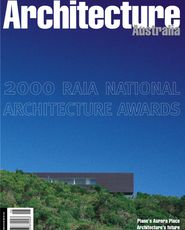SYDNEY BUNGALOW DEFINED
The use of types may seem like mere semantics to some, but when a clear misnomer occurs, it calls for some honest redefinition of terms, if not a new type to be defined. Regularly in the daily press’s property columns and even in some published architectural books, the use of the type “Californian Bungalow” is used to describe a form that is clearly of Sydney, if not southern Australia. The key features of the Bungalow style in Californian are: a low pitched sheet or shingle roof; relaxed floor plan with no hallways; timber-framed structure; a porch, as an outside room, relating to the garden; texture-panelled ceilings with exposed beams; and overall, more simple decoration. However, what is observed in Sydney is: steeper pitched roofs, with Marseille terracotta roof tiles; a central truncated hallway with rooms off it in a symmetrical format which is more in the tradition of a villa (as Aldo Rossi defines it) than in the spirit of an asymmetrical floor plan; cavity brick work with pointing on the front elevation which is the prevalent construction method; a front porch as an intermediate space to the street, often too small to put a table in; high ceilings (often three metres), smooth plaster and no exposed beams; and often the “main room” has a metal Victorian fireplace-surround and Victorian ceiling rose. Bungalows were from colonial India. In England they now mean a single storey house. But what seems to have happened here in Sydney at the time the new garden suburbs were being built is the local builders marketed the new house type as a California Bungalow, when it is really a local variant on a world-wide idea of a bungalow. A more accurate name would be the Sydney bungalow.
Michael Neary
PRACTICALITY
A delightful letter from Ken Green (AA July/August 2000). AA is a quality magazine, I suspect we would all agree, but what Ken Green says is absolutely correct. Well he does have some expert knowledge, and you don?t need that much knowledge to observe that most magazines, journals, novels and newspapers intended for quick consumption use a Roman serif type face. Yet some of these journals have very high quality printing and photography. I must say, like Ken I suspect, over the years I have only read what I found essential to understand the graphics, if I was so moved. As half the magazine is typography, it means you don’t get much for your subscription. I persisted determinedly to read the article by Jim Service (AA, March/ April 2000) in tiny condensed sans serif. It was by a man who is a renowned organiser and is chairman of many organisations, both government and non-government (including the National Museum of Australia), all of which commission large and small buildings from architects. He took the trouble to write this very comprehensive letter, politely addressed, pointing out shortcomings in architectural practice and which service could readily be obtained elsewhere. This is vital knowledge for all architects and for architectural education. To suppress the article by making it time consuming to read is not practical. The letter addresses matters that have been brewing for years; they need open discussion. No doubt RAIA council are discussing or have discussed the criticism, fairly made, but how are the members informed and how are the matters being addressed? You have to say that AA is “slick”, but I for one have never thought that was an adequate description for the representation of a professional organisation.
Tony Matthews
FEDERAL OR NATIONAL?
As a senior member of the profession and, for three terms, a member of National Council, (more correctly, at that time, Federal Council) I am far from convinced by the arguments put forward by National President Haysom in the latest Architecture Australia. Until the restructure, which I opposed vigorously, the RAIA was a federal organisation with states maintaining their independence, but linked together through the National (or Federal) Council. To “talk up” the present system by pretending that state involvement still has some significance is, to say the least, misleading. It was I who moved in 1961 that the South Australian Institute of Architects become a chapter of the RAIA, on the clear understanding that state independence would be maintained. This understanding has since been violated. The maintenance of many chapter activities is now becoming increasingly farcical,
|
|
as the chapters (in small states in particular) have no decision making role at all. It is quite obvious that small states with minute voting power have no rights whatsoever, and are simply subject to the rulings of the larger states (mainly NSW and Victoria). Prior to the so-called restructure, the Institute was a federal body in the same way as our Federal Parliament is today. The argument that the “national structure” is essential for the RAIA to be a viable and effective organization, by generating economies of scale, is a tired and discredited proposition. We all know now, and indeed some of us knew from the beginning, that centralised power and control would disadvantage architecture by cutting out the voices of the states, all of which were originally separate institutes, federated into the Royal Australian Institute of Architects. The “chapters” in the smaller states are now little more than a charade, with their control vested in an executive officer who is directly answerable to Canberra. The change from federal to national is a major structural change that has deterred permanently the nature, intent and status of Australia’s Institute of Architects. It is hardly surprising that Canberra can now confidently advocate the rebuttal of the honour bestowed upon us by the Queen of Australia - the Royal Charter. It matters not how heartily the states (and particularly the small states) might object and protest, the national body, controlled mainly by the Canberra bureaucracy, can, and no doubt will, push on with this narrow and politically motivated change. The fact that a referendum has been conducted around Australia in recent times, and produced a resounding endorsement of the monarchy, is, apparently, of no concern to those pushing their narrow prejudice. We, the members, will it seems “just have to wear it”. Surely nothing could better illustrate the illicit transfer of power and control than this particular issue. In addition, the apparent passive acceptance of the outrageous proposal by the Productivity Commission to rescind architect’s registration acts in all states is indicative of the complete transfer of control and power. I would ask President Haysom not to pursue his lame argument that state powers and input are still maintained and respected, it does him no credit.
John Chappel
THE RAIA RESPONDS
The errors in John Chappel’s letter indicate that he is sadly misinformed about the RAIA. The following are points of fact: The RAIA has been a national, not federal, organisation since it was incorporated about seventy years ago. The restructure did not alter the form of incorporation; the RAIA continues to be a public company limited by guarantee. RAIA Chapters have never been independent organisations. The former State Institutes abandoned their sovereignty in 1929 in order to establish the RAIA. Control of the RAIA Chapters is not vested in the Executive Officer (the State Manager), who is charged with managing Chapter resources. Political power rests with the Chapter Council and in particular the Chapter President who is an elected National Councillor. Chapter Presidents sit on the National Council along with four other councillors elected from the membership at large, plus a SONA representative. The RAIA is not formed under a Royal Charter from the Queen of Australia. The proposal to change the name of the Institute came from an elected National Councillor not the “Canberra bureaucracy”. The RAIA has actively dealt with the Productivity Commission’s review of the architects legislation. We have published articles in the daily press, on our website and in Architecture Australia, Memo, RAIA email news and Briefings. We have lobbied politicians and given evidence directly to the Productivity Commission. The Institute’s submissions to the Productivity Commission and related press releases can be viewed on our website.
Ed Haysom, RAIA National President
FIX
APP Corporation advise that we missed their credit as project managers for the Dunc Grey Velodrome in the September issue.
We welcome your concise views on issues of interest to architects. Please provide contact details - we may need to edit. The RAIA has right of reply to letters criticising the Institute. Address correspondence to Architecture Media, Level 3, 4 Princes Street, Port Melbourne, Victoria 3207. Fax (03) 9646 4918. Or email us at |















